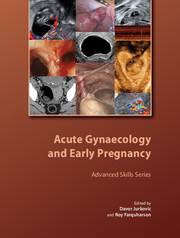Book contents
- Frontmatter
- Contents
- About the authors
- Acknowledgements
- Abbreviations
- Preface
- 1 Organisation and delivery of emergency care in early pregnancy and acute gynaecology
- 2 Epidemiology and aetiology of miscarriage and ectopic pregnancy
- 3 Diagnosis of miscarriage
- 4 Conservative and surgical management of miscarriage
- 5 Management of hyperemesis gravidarum
- 6 Diagnosis and treatment of recurrent miscarriage
- 7 Differential diagnosis and management of molar pregnancy
- 8 Drugs in early pregnancy
- 9 Diagnosis of tubal ectopic pregnancy
- 10 Conservative management of tubal ectopic pregnancy
- 11 Surgical management of tubal ectopic pregnancy
- 12 Diagnosis and management of non-tubal ectopic pregnancy
- 13 Diagnosis and management of acute pelvic pain
- 14 Management of vaginal bleeding in the acute clinical setting
- 15 Current concepts in screening and outpatient management of pelvic inflammatory disease
- 16 Diagnosis and management of haemorrhagic and septic shock
- 17 Role of minimally invasive surgery in acute gynaecology
- Index
16 - Diagnosis and management of haemorrhagic and septic shock
Published online by Cambridge University Press: 05 July 2014
- Frontmatter
- Contents
- About the authors
- Acknowledgements
- Abbreviations
- Preface
- 1 Organisation and delivery of emergency care in early pregnancy and acute gynaecology
- 2 Epidemiology and aetiology of miscarriage and ectopic pregnancy
- 3 Diagnosis of miscarriage
- 4 Conservative and surgical management of miscarriage
- 5 Management of hyperemesis gravidarum
- 6 Diagnosis and treatment of recurrent miscarriage
- 7 Differential diagnosis and management of molar pregnancy
- 8 Drugs in early pregnancy
- 9 Diagnosis of tubal ectopic pregnancy
- 10 Conservative management of tubal ectopic pregnancy
- 11 Surgical management of tubal ectopic pregnancy
- 12 Diagnosis and management of non-tubal ectopic pregnancy
- 13 Diagnosis and management of acute pelvic pain
- 14 Management of vaginal bleeding in the acute clinical setting
- 15 Current concepts in screening and outpatient management of pelvic inflammatory disease
- 16 Diagnosis and management of haemorrhagic and septic shock
- 17 Role of minimally invasive surgery in acute gynaecology
- Index
Summary
Introduction
Shock is a systemic disorder affecting multiple organ systems. Its early recognition and prompt treatment are very important as there is a direct correlation between the duration and severity of tissue hypoperfusion and poor outcome. This chapter describes the pathophysiology of haemorrhagic and septic shock, early diagnosis and principles of effective management.
Definition and mechanism of shock
Shock is a state of compromised tissue perfusion that causes cellular hypoxia. It is defined as a syndrome initiated by acute hypoperfusion leading to tissue hypoxia and vital organ dysfunction. During shock, perfusion is insufficient to meet the metabolic demands of the tissues and anaerobic metabolism occurs. This is unsustainable and, if not corrected, will progress to cellular dysfunction, cell death and end organ damage. The progressive chain of events that occurs as shock develops is summarised in Figure 16.1.
Recognition of shock
Prompt stabilisation of the woman's condition and treatment of the underlying cause of the shock can avoid the rapidly spiralling deterioration that leads to cell damage and, ultimately, death. The recognition of shock is clinical and depends on identification of the cluster of subtle signs associated with the development of tissue hypoxia and dysfunction. Tachypnoea and tachycardia are often early signs of shock, followed by hypotension and poor urine output. Only once shock has progressed some way will the patient also show the classic picture of pale, clammy skin, cool peripheries and an altered level of consciousness.
- Type
- Chapter
- Information
- Acute Gynaecology and Early Pregnancy , pp. 211 - 222Publisher: Cambridge University PressPrint publication year: 2011



